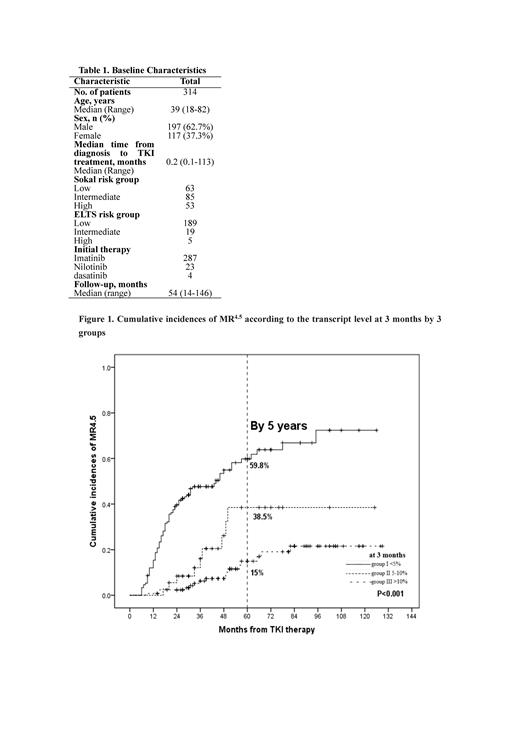Background: Early acquisition of a deeper molecular response (DMR) and maintenance of a sustained DMR are prerequisites for implementing treatment-free remission (TFR) in CML patients.
Earlier identification of patients who have not reached 24-month DMR and timely intervention is particularly important for patients with a strong desire for TFR. Early molecular response (EMR) of BCR-ABL1 mRNA <10% at 3 months after the initiation of TKI therapy is strongly predictive of a 12-month major molecular response (MMR). Whether the EMR <10% is also a good predictor of the 24-month DMR is unknown. Exploring early predictors of 24-month DMR could help guide clinical treatment decisions and advance the implementation of the TFR plan.
Aim: Exploring early predictors of 24-month DMR.
Methods: We performed a retrospective analysis of all adult patients with newly diagnosed CML-CP in the Department of Hematology at Guangdong Provincial People's Hospital (Guangzhou, China) between Mar 2009 and May 2019. Patients were monitored with BCR-ABL1 mRNA quantitative RT-PCR monthly for the first 3 months of TKI treatment, then every 3 months for a minimum of 2 years, and then every 3 to 6 months.
Results: A total of 314 patients with complete medical recorders and routinely monitoring BCR-ABL1 mRNA transcript data of each molecular response milestone were enrolled. Patients' characteristics are summarized in Table 1. The median follow-up time was 54 months (14 to 146 months). The 5-year cumulative rate of MMR, MR 4 and MR 4.5 with TKI treatment were 80%, 48.1%, and 38.4%, respectively.
The results of the ROC analysis showed that a 3-month BCR-ABL1 mRNA transcript level of 4.94% correlated well with the 24-month DMR. The sensitivity and specificity of its predictive function were 82.8% (95% CI, 73.6-89.8) and 66.97% (95% CI, 60.3-73.1), respectively. So, we adopted BCR-ABL1 mRNA transcript level ≤4.94% at 3 months as the optimal threshold for predicting 24-month DMR.
To reveal the cumulative incidence (CI) of 12-month MMR, 24-month MR 4 and MR 4.5 at different thresholds of BCR-ABL1 mRNA transcript levels at 3 months. Patients were divided into 3 groups according to the BCR-ABL1 mRNA transcript levels, group I <5% (n=150, 47.7%), group II 5% to 10% (n=36, 11.5%), group III >10% (n=128, 40.8%). Patients with BCR-ABL1 mRNA transcript levels <5% at 3 months after TKI initiation are more likely to achieve DMR than the other two groups and take less time to achieve DMR.
Patients of Group I with 12-month MMR and 24-month MR 4 were significantly higher than the other two groups, with 66.7% vs 30.6% or 8.6% and 50% vs 16.1% or 7% (P<0.001), respectively. And group II was compared with group III. The cumulative incidence of MMR, MR 4 and MR 4.5 was also significantly higher in Group I than in the other two groups (Fig.1). The survival outcome of patients with BCR-ABL1 transcript levels <5% at 3 months had significantly superior compared with those with BCR-ABL1 transcript levels ≥5%: the 5-year EFS, PFS and OS were 88.6% vs 86.4% (P=0.037), 100% vs 95.7% (P=0.011) and 100% vs 95% (P=0.014), respectively (Fig. 1).
Conclusion: BCR-ABL1 mRNA transcript levels <5% at 3 months is a new landmark EMR (EMR <5%) which can predict 24-month DMR for patients with TKI treatment. EMR <5% may be used to guide the clinical timely switching of TKI or treatment and facilitate the implementation of TFR.
Disclosures
No relevant conflicts of interest to declare.


This feature is available to Subscribers Only
Sign In or Create an Account Close Modal